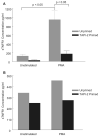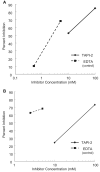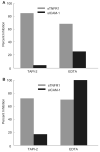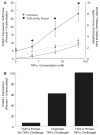Regulation of the receptor for TNFalpha, TNFR1, in human conjunctival epithelial cells
- PMID: 18487372
- PMCID: PMC2581452
- DOI: 10.1167/iovs.08-1873
Regulation of the receptor for TNFalpha, TNFR1, in human conjunctival epithelial cells
Abstract
Purpose: Previous studies demonstrated that mast cell-derived TNFalpha stimulation is critical to the upregulation of intercellular adhesion molecule (ICAM)-1 on human conjunctival epithelial cells (HCECs), which is an important feature of ocular allergic inflammation. Shedding of TNFR1 by TNFalpha-converting enzyme (TACE) is a primary mechanism for the regulation of TNFalpha-mediated events. This process has not been examined in HCECs. In this study, the authors examined the regulation of TNFR1 expression and shedding by TACE on primary HCECs and the IOBA-NHC conjunctival epithelial cell line.
Methods: Primary human conjunctival mast cells and epithelial cells were obtained from cadaveric conjunctival tissue. HCECs were incubated with and without activators (IgE-activated mast cell supernates, phorbol myristate acetate [PMA; to activate TACE], TNFalpha, and IFNgamma [to upregulate TNFR1]) for 24 hours. Pretreatment with the TACE inhibitor TAPI-2 was used to inhibit shedding of TNFR1. Supernates collected from the incubations were analyzed with ELISA for soluble TNFR1 (sTNFR1). With the use of flow cytometry, cells were harvested from these experiments for analysis of TNFR1 and ICAM-1 receptor expression.
Results: IgE-activated conjunctival mast cell supernates upregulated the expression of TNFR1. TAPI-2 inhibited the PMA-induced release of sTNFR1 receptor and enhanced the surface expression of TNFR1 in HCECs in a dose-dependent manner. Upregulation of TNFR1 expression by priming with TAPI-2 and IFNgamma resulted in enhanced ICAM-1 expression in response to TNFalpha stimulation (significant change in the slope of the dose-response curve).
Conclusions: These results demonstrate that TACE promotes TNFR1 shedding in HCECs and that TNFR1 expression may be a more significant target than TNFalpha for intervention in ocular inflammation.
Figures







References
-
- Schultz BL. Pharmacology of ocular allergy. Curr Opin Allergy Clin Immunol. 2006;6:383–389. - PubMed
-
- Baudouin C, Liang H. Amplifying factors in ocular surface diseases: apoptosis. Ocul Surf. 2005;3(suppl):S194–S197. - PubMed
-
- Cook EB, Stahl JL, Barney NP, Graziano FM. Olopatadine inhibits anti-immunoglobulin E-stimulated conjunctival mast cell upregulation of ICAM-1 expression on conjunctival epithelial cells. Ann Allergy Asthma Immunol. 2001;87:424–429. - PubMed
-
- Bode L, Murch S, Freeze HH. Heparin sulfate plays a central role in a dynamic in vitro model of protein-losing enteropathy. J Biol Chem. 2006;281:7809–7815. - PubMed
Publication types
MeSH terms
Substances
Grants and funding
LinkOut - more resources
Full Text Sources
Other Literature Sources
Miscellaneous

